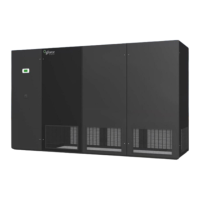9
of the unit and noting any discrepancies. A copy of the log sheet should be sent to Data Aire.
Failure to perform the long-term storage requirements may void the warranty.
Suggested Reference Storage Room Conditions
• Dry bulb temperature range: 65°F to 85°F.
• Effects of high temperatures may dry out components or may damage electrical
components.
• Effects of low temperatures may cause freezing damage to coil, compressor, system
components, electrical components, etc. Freezing temperatures must be avoided.
• Humidity range: 25 to 50% RH.
• High humidity may cause damage to insulation and electrical components. Storage in
moist air, above 50%, should be avoided. High humidity may cause rust on metal
components such as sheave, pulley, blower housing, cabinet parts, supports, etc.
• Low Humidity may cause brittle conditions to components within the unit. At low
humidity, problems of brittleness or electrical static might arise for the equipment.
• Level with floor.
• Units with compressor maximum tilt angle is 30° (compressor not running) but
recommend the unit be set level for 24 hours prior to final installation.
• Store at non-condensing temperature and humidity conditions.
General Storage Considerations
• All equipment shall be stored for safety of occupants. Per OSHA codes and codes
applicable to your installation.
• Maintain clearance from working space and traffic areas.
• Our indoor products are not designed or intended to be stored outdoors or exposed to
outdoor conditions.
• Components sealed in plastic shrink-wrap are not exempt from this requirement.
Moisture will collect inside the plastic, resulting in corrosion of the cabinet, the electronic
components and or other water sensitive components.
• Provide proper fire protection per local and national codes.
• Protect from all water or fluid sources. Equipment should be protected from possible
water damage, such as from leaks, fire-sprinkler discharge, and flooding.
• The storage space should be filtered to remove dust, cleansed of gaseous
contaminants, if present, and controlled to the desired relative humidity and
temperature.
• Isolate this equipment from pressure testing of water, steam, gas and air piping.
• Isolate this equipment from temporary building power.
• The unit must also be protected from damage to the exterior of the cabinet or coil
connections by construction vehicles and personnel.
• Isolate from vibration sources.
• Isolate from direct sun light.
• Isolate from storage of hazardous materials and substances.
• Refrigerant coils have been evacuated and pre-charged with slight nitrogen holding

